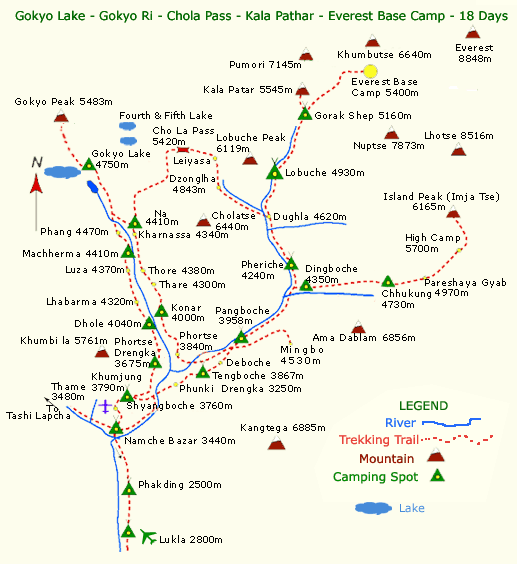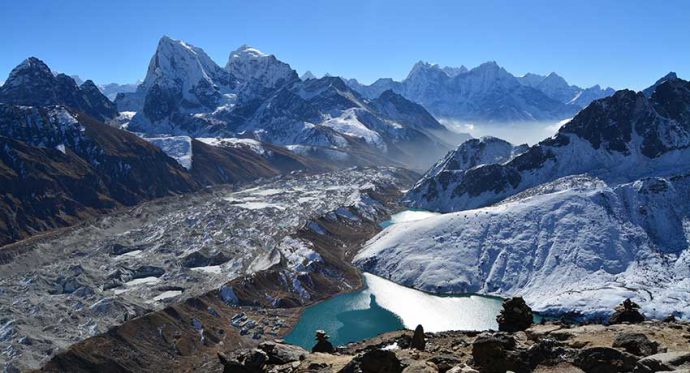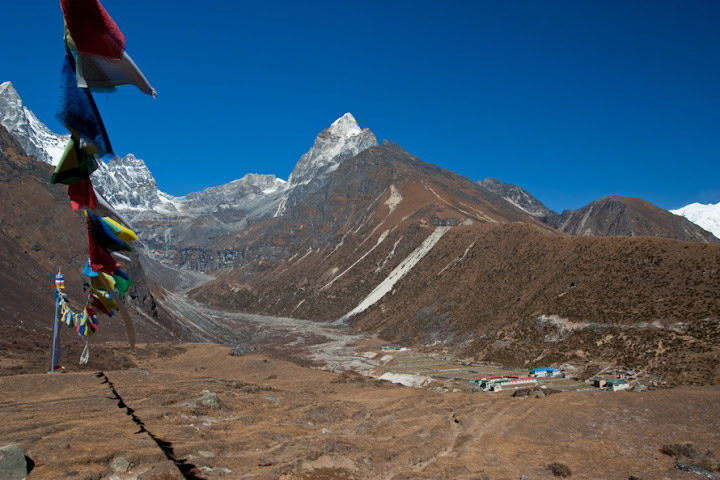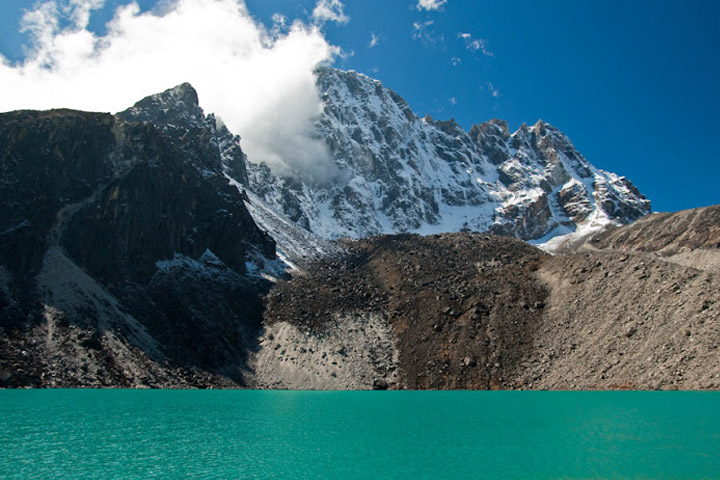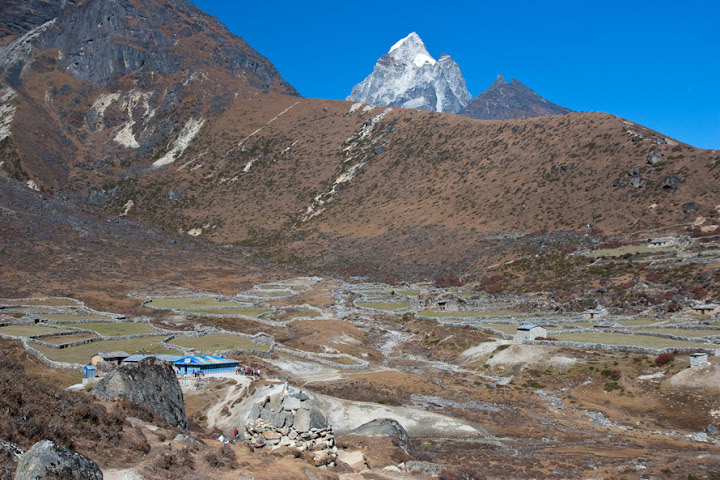Gokyo, A hidden valley with few glacier lakes and Everest Base camp has own meaning for adventurous peoples. This is one of the popular and adventurous treks at higher places of Khumbu valley. The Khumbu region is intelligibly one of the most popular and a spectacular destination for adventure seekers and it offers the best opportunity to gain the Himalayan experience. This trek begins with a dramatic scenic flight to Lukla and the trail follows many farm villages with beautiful views of the high snow capped peaks of the world, and to the famous view point Gokyo ri and higher pass Cho La with the highest spot at Kalapathar for the outstanding breathe taking panoramic view of glacier lakes, many higher mountains including Mt. Everest. To visit the Everest Base camp, glaciers and lakes figuring in different shapes makes you over whelming and glacier cracking sound makes you fear love. Sagarmatha National Park is listed by world heritage sites, which cover Everest region and offers the spectacular view of the highlights of higher mountains as well as friendly Sherpa people, who are break recorder to climb the highest mountains along Mt. Everest. Himalayan wildlife commonly seen as musk dear, mountain goats, colorful Pheasants besides these rare species of Red Panda & Snow Leopard are an another attraction for the visitors. Pine and birch tree are the common forest here as well as colorful rhododendron flowers welcome you on spring. Monasteries can be found most of the places in bottom part, which makes you spiritual soul, and the flattering flags can be seen everywhere. This trek is popular classic trek shall visit once for lifetime experiment.
Day 01: Arrival in Kathmandu: 1300m/4265ft (BB)
Arrival in Kathmandu where you will be met at the airport and transferred to Hotel, just walking distance to any styles of good restaurants and shops. Our Representative will give you short briefing on hotel facilities and safety. Tonight we only have a short introduction to the area, just what you need to know before the main briefing tomorrow. O/N at Hotel Nirvana Garden in Kathmandu.
Day 02: Sightseeing of World Heritage sites: (BB)
After breakfast, trek briefing will take place around 9 am. All aspects of gear and conditions are discussed to make sure you’re fully prepared for the trip, and any last minute questions answered. After lunch we explore this medieval capital. We visit Boudhanath, also known as little Tibet. Then we visit Pasupatinath, holy temple of Hindu where cremation takes place by the holy river Bagmati. Later we visit Patan Durbar Square. Evening: welcome dinner hosted by Basanta Adventure. O/N at Hotel Nirvana Garden in Kathmandu.
Day 03: Fly to Lukla and Trek to Phakding: 2610m/8560ft, Lunch at Phakding: (Full Board)
Take the morning flight a thrilling experience to the dramatic airfield at Lukla (2,860m) where we are immediately in amongst the peaks. The sudden change in altitude can leave some of us quite breathless, but we descend to Chaplung (2680m) before lunch to let ourselves adapt more gradually. The afternoon is an easy introduction to the trek up the beautiful Dudh Kosi river valley, passing huge carved mane stones and prayer wheel shrines, to our night lodge at Phakding. The lodges on the first half of the trek are good: twin rooms with comfortable mattresses and nice glazed dining rooms with stoves for cold weather days. The menus include all sorts of wholesome favorites: pasta, noodle and rice dishes with remarkably fresh vegetables, puddings and every variety of hot drinks. The lodges have the same pattern all the way up, but understandably they become a bit more simple right at the top of the trek – though still remarkably good for the location. We always select the best of the standard lodges in each night stop. O/N at Tashi Taki lodge in Phakding.
Day 04: Trek to Namche: 3440m/11283ft, Lunch at Jorsale: (Full Board)
Through blue pine and Rhododendron forests we continue gradually upriver to reach Monzo at the entrance to the Sagarmatha (Everest) National Park. Just beyond, after crossing the river on one of the excellent new pedestrian suspension bridges, we take lunch at one of the tea houses that line the banks at Jorsale (2775m). So far our gain in height has been barely perceptible, but the afternoon sets us a fairly tough challenge, exaggerated by the early stage of our acclimatization. Rising first to cross a marvelous bridge high above the Imja Khola, we then gradually ascend the ridge opposite. And halfway up, we should be able to look out for our first view of Everest ahead. We must also look out for pack-yaks which we will see from now on; generally good natured, we should still keep up-side of these huge beasts – avoiding a playful nudge! We arrive at Namche Bazaar, the Khumbu district capital, built within a natural amphitheatre setting surrounded by peaks, and now a thriving lodge town. O/N at Yak Hotel in Namche.
Day 05: Acclimatization day at Namche:
The first of our carefully planned days to allow us to adapt naturally to gain in altitude. There is plenty to do and explore around Namche, including the Sherpa museum above the village, hike up to Thyamboche etc. O/N at Yak Hotel in Namche.
Day 06: Namche to Dole: 4200m/13776ft, Lunch at Phortse Thanga:
After stroll around the Namche area, today we refreshed and fairly easy to walk further on. Our walk follows on the gradual trail with few short up and downs overlooking magnificent view of the great giant snow peaks from Everest, Nuptse, Lhotse, Ama Dablam, Thamserku and Kwangde peak after a pleasant walk of two hours to a small place at Shanasa, from here and trek ascents the left side to Mongla hill and continue down to Phortse Thanga. Enjoy the walking and further few hours walk ascending will reach at Dole for overnight. A small place with few teahouses and enjoy your night at Dole. O/N at Himalayan Lodge in Dole.
Day 07: Dole to Machharmo: 4470m/14662ft, Lunch at Machharmo: (Full Board)
Firstly we climb to the scenic ridge above the Dole and the trail climbs via Lhabarma at 4220m to Luza at 4360m. The path is steep in most places as it climbs through scrub to Lhabarma. The trail continues to climb along the side of the valley high above the river, crossing sandy spurs to reach Machharmo at 4410m. It was in Machharmo in 1974 that one of the first Yeti sightings was reported in Khumbu. There are few good condition hotels and good mountain views from Machharmo. O/N at Namgyal Lodge in Machharmo.
Day 08: Machharmo to Gokyo: 4790m/15711ft, Lunch at Gokyo: (Full Board)
Today, we climb up to the ridge and can be seen excellent view both down the valley to Khangtega and northern part to the Cho-Oyu (8153m). Beyond the ridge the valley widens as the trail passes through Pangram at 4390m. We descend to the river bank before beginning the climb up to the terminal moraine of the Ngazumpa glacier. It is a steep climb on the moraine. Afterwards the trail levels out as it follows the valley past a second lake, known as Longponga at 4690m, where you’ll have chance to find the Lama Foot prints on a stone. Enjoy the lake view and after an hour walk will reaches at Gokyo valley, on the edge of third lake. There are some few teahouses with comfortable bed room and after lunch explore around the Lakeside. O/N at Gokyo Resort in Gokyo.
Day 09: Hike to Gokyo RI and trek to Dragnak: 4700m/15416ft, Lunch at Gokyo: (Full Board)
This morning hike up the to Gokyo Ri for the breathtaking view of splash a sunrise top of the mountain including Mt. Everest view and many more nameless peaks. This will be unforgettable life time memories and enjoy around the top. We have a great memories and stroll back an hours to Gokyo for breakfast. We trek down to Dragnak for the overnight passing through the second lake and walk on the glacier and will reaches at Dragnak. O/N at Yeti Hotel in Dragnak.
Day 10: Trek to Dzongla via Cho-la Pass: 4820m/15842ft, Lunch is Packed-Lunch: (Full Board)
Today, we walk in the high passes and one of the tough days to cross the Cho-la. The pass is not difficult but it is steep and involves a glacier traverse on the eastern side. After crossing the Cho-la pass we reach at Dzongla for overnight stop at teahouse. It has a very basic dorm room with cozy dining. Enjoy the fantastic view around the high above. O/N at Yak Hotel in Dzongla.
Day 11: Dzongla to Lobuche: 4910m/16105ft, Lunch at Lobuche: (Full Board)
An easy half day today after the pass. The morning is short and level, contouring toward the Khumbu valley, with the amazing view of Ama Dablam to the south. Round the corner, the Khumbu glacier stretches away in front of us. We continue on the level as it comes up to meet us, and after crossing a side valley, we reach our lodge at Lobuche. Rest up in the afternoon ready for another exciting day tomorrow. O/N at Sherpa Lodge in Lobuche.
Day 12: Trek to Kalapathar (5550m/18204ft) and back to Gorakshep: 5140m/16895ft, Lunch at Gorakshep: (Full Board)
Early morning we hike slowly for 3 hours through stony & dry hill to reach Gorakshep for breakfast. After breakfast, we hike up to the Kalapathar which takes about 2 hours to reach the top from where we can have an opportunity to enjoy the breathtaking Panoramic & Magnificent views of Mt. Everest (8,848m/ 29,030ft), Nuptse, Pumori, Ama Dablam, Thamserku and many more High Tibetan Himalayas with colorful Sunrise. You will have a wonderful time at Kalapathar and it will be an unforgettable memory in your life. Later, we come back to Gorakshep for lunch. O/N at Himalayan Lodge in Gorakshep.
Day 13: Trek to EBC (5364m/17594ft) and back to Gorakshep: 5140m/16895ft, Lunch is Packed-Lunch:
Today we continue hike to Everest Base Camp. The trails over here can be misleading, follow the lead Sherpa, every year the trail changes due to the momentum of the glacier, the walk is quite strenuous due to the high altitude and less oxygen. The walk passes through over rocky dunes and moraine and streams, till you reach the Base Camp. It is a base camp for the climbers to set up their camps & acclimatize before heading for Summit of Mt Everest. If you get here at the time of climbing season you can explore with lively expedition groups. Later come back to Gorakshep. O/N at Himalayan Lodge in Gorakshep.
Day 14: Gorakshep to Dinboche: 4410m/14465ft, Lunch at Thugla: (Full Board)
After breakfast trek down to Dhugla then go straight up the hill from the bridge to reach an upper trail. Staying high above the valley floor, we pass the yak pasture at Dusa to a chorten at the head of the Imja valley. Dingboche is the only place in Khumbu where barley is grown, enjoy the scenery. O/N at Island Peak View Lodge in Dinboche
Day 15: Trek to Kyangjuma: 3550m/11644ft, Lunch at Deboche: (Full Board)
The walk today will be easy heading downhill to a lower elevation from Dingboche the walk is pleasant all the way to Kyangjuma. After the bridge our route descends following the stream towards Pangboche village, and further down to Kyangjuma is one of the most beautiful places in the Himalaya. O/N at Thamserku Lodge in Kyangjuma.
Day 16: Trek to Phakding: 2610m/8560ft, Lunch at Monzo: (Full Board)
Trek down to Phungithanka a small settlement with couple of teahouses. The trail leads downhill through the forested path of silver fir, blue Pines, Rhododendron and some few Magnolia and Birch trees. After crossing the suspension bridge over the Dudh Koshi River, trek onwards to the Sanasa and trek further down to Phakding. O/N at Tashi Taki Lodge in Phakding.
Day 17: Trek to Lukla: 2840m/9315ft, Lunch at Lukla: (Full Board)
We trek back enjoying the lush green scenery around and passing through the incredible mountain scenery and local Sherpa village. Arrival in Lukla and you’ll have time to stroll around the areas and Guide will re-confirm your flight ticket. This will be your last night with your trekking crew except trekking Guide. Trekking crew will organize a farewell ceremony, Nepali song and dance, staff members will be allowed to drink to join the party. You may want to try local drink called “Rakshi”, please be aware; it does not taste good and is very strong. O/N at Kongde Lodge in Lukla.
Day 18: Fly Lukla to Kathmandu: (BB)
The flight time to Kathmandu, are schedule for morning normally, because of the wind in the afternoon, sometime the flight time can be delayed due to bad weather and other reason beyond our command. Anyway we will fly back to Kathmandu. You will be transferred to hotel. Upon arrival in Kathmandu, any hire gears will be collected and your international flight tickets will be distributed. O/N at Hotel Nirvana Garden in Kathmandu.
Day 19: Day at leisure: (BB)
This pleasant day you may have full day at leisure and either relax at hotel or explore Kathmandu city, shopping etc. O/N at Hotel Nirvana Garden in Kathmandu.
Day 20: Holiday extension or final departure:
Today either you’ll have your holiday extension for another tour or we will transfer you to airport for final departure flight.
Note: The above information is a guide and standard template of what we provide. The trek can be customized at your request to accommodate your specific requirements.
Note : On adventure trips of this type, weather, local politics, transport or a multitude of other factors beyond our control can result in a change of itinerary. It is, however, very unlikely that the itinerary would be substantially altered; if alterations are necessary the leader will decide what is the best alternative, taking into consideration the best interests of the whole group. Where a change does occur, we do everything we can to minimize its effect, but we cannot be responsible for the results of changes or delays.
Q.What type of shape do I need to be in, is this trip for me?
A. Trekking is suitable for average people who are moderately fit, thus no previous experience is required. Some physical fitness programs such as running, swimming, hiking is recommended before you embark on your journey. Persons suffering from a pre-existing medical condition or disease must seek medical advice before considering the trek. Whilst on the trek, it is common to experience some discomfort before being fully acclimatized.
To prepare for a strenuous trek you should begin training at least two to three months before your departure. As a guideline, an hour of aerobic exercise three to four times per week would be considered a minimum requirement. The best preparation is bushwalking involving relatively steep ascents and descents. If you can manage a couple of valley floor to ridgeline ascents per comfortable and able to enjoy the trek to the fullest. They are physically strong, sharp-witted and have an incredibly positive attitude towards a life that we would consider extremely tough. There is something about a trek in the Himalaya that draws you back time and time again. For keen walkers it is a paradise and even avowed non-walkers find that one foot just seems to follow the other, drawn by the appeal of what lies beyond.
Q. Will somebody come to pick me up at the Airport upon my arrival?
A. Yes, our Airport Representative will be there to greet you outside of Terminal Hall, he/she will be displaying an Kiwi Adventures Treks & Expedition sign board. Upon arrival, you will be transferred to your hotel.
Q. What sort of accommodation can I expect in Kathmandu and in trekking?
A. 11 night’s Trekking Guesthouse, 4 nights three/four star hotels in Kathmandu.
We use standard rooms from three/four star hotels in Kathmandu with breakfast included. Along the trekking routes teahouses/Lodges generally provide basic clean facilities with a mattress and a quilt or blanket. We can also offer you sleeping bags if needed (which need to return after the trip) but it is a good idea to always have your own sleeping equipment. We usually provide single and double rooms as well as the occasional dormitory. The dining room is downstairs around a fire. All food will be cooked to order in the little kitchen. You should not enter the kitchen unless asked to do so.
Q. What sort of food can I expect in trekking?
A. In trekking most teahouses (lodges) cook a delicious range of mostly vegetarian fare. Pasta, tuna bakes, noodles, potatoes, eggs, dhal bhat, bread, soups, fresh vegetables (variety depends on the season) and even some desserts like apple pies, pancakes, and some interesting attempts at custard. You will find a lot of garlic on the menu because it assists with acclimatization – eat some every day. In many larger villages you may find some meat on the menu. You can always get hot chocolate, tea, and hot lemon drinks, as well as soft drinks, and treats like chocolate and crisps.
Each day dinner and breakfast are used to take in the same lodge you spend the night. Lunch will be taken on the way to destination.
Q. What sort of transportation you use?
A. Kiwi Adventures Treks & Expedition is all about providing you with local insights as well as adventure, with that in mind, where we think you will get more out of your holiday by using different means of transport that is what we do. Using a variety of private transport is an integral part of our Himalaya tours and enhances the experience!
We use private tourist vehicles for sightseeing, city tours and pickups. Depending on the group size we use cars, minibus, van or land cruiser. These small light vehicles are more manoeuvrable and flexible enabling us to take you through the Narrow roads of Nepal. All the vehicles are usually air-conditioned unless we are travelling in cooler areas.
Q. What is the best season for this trekking?
A. Our trekking season extends from mid- September to May. From early September the monsoonal rains decrease. By end of September through to December the weather is usually stable with mild to warm days, cold nights. February, March, April, May, October, November, December are the best time to do trek.
Q. What is the weather & temperature like in trekking?
A. Weather in the mountains is notoriously difficult to predict. At night it is generally cooler the days are generally warm. Winter (January and February) will be bit colder but the days can be quite beautiful and warm if the sun is out. There will be bit of snow during the month of January, February and December. It is also important to make sure that you can stay warm and dry in just about any conditions. Expect the unexpected! The temperature could be as high as 20 deg C to -15 deg C low.
Q. Can I charge my digital camera or other batteries on my trip?
A. These facilities will be available in most of the places in your hotel reception by paying some service charges. Remember to bring your adapters!
Q. Is there any communication while we are on trekking?
A. There are telephones in some villages along the trekking routes from which you can make international calls.
Q. Can I use credit cards in the places visit in trekking?
A. In most cities yes, to some extent, however once you leave those cities behind, all you need is cash.
Q. How much additional money do I need per day?
A. In Kathmandu, you can allocate US$ 10 – 25 for a lunch / dinner. It’s all depends on your spending habits. US$7 to 10 US$ a day will be enough to buy bottles of water, chocolates and few drinks in trekking.
Q. Do I need to tip my guide and porters? How much would that be?
A. This is a difficult thing to gauge. We have seen everything from 20USD to 1000 USD per person for guides and porters. Tipping is not required, but a small way to show your guides and local porters thanks for their help. The level of the tip should reflect the level of personal involvement with your guide.
Q. Is the water OK to drink? Do I need to bring purifying tablets/filter?
A. In most places bottled water is readily available. If you wish to drink normal water, you need to use purifying aid, which you will need to bring with you.
Q. Are the Kiwi Adventures Treks & Expedition staff insured?
A. Our company insures all our trekking staff, including guide, cook, sherpa and porters.
Q. What essential documents do I need to bring with me on tour?
A. *Valid Passport – must be valid for up to 6 months after you return from your tour, keep a separate photocopy.
*Travel insurance, keep a separate photocopy
*Cash and Traveller’s Cheques, keep numbers and proof of purchase separate
*Flight tickets
*Emergency contact numbers for T/C’s, banks, insurance, family contacts.
Q. Can I add extra days to my trekking trip?
A. A hoilday should never be about making it to the final point quickly. Along your trek we can add days at your request with additional costs to cover guides, porters, accommodation and food.
Q. Do you use yaks/porters on the trek or do we carry all of our own gear?
A. Whilst on the trek, our porter will take care of your luggage. All you need to carry is your small day bag for your personal belongings like camera, water bottle, sun cream etc only.
Q. What opportunities will I have for shower along the trek?
A. In major places, we arrange guesthouse with hot shower. And in rest of the places, hotel water in bucket will be provided for shower; it would cost you extra about USD 3-4 per shower.
Q. Do you know about how many total miles the trek is?
A. Total distance of the entire trek is about 75 miles.
Cost Includes
• Airport / Hotel / Airport pick up & drop by private car / van / bus.
• Standard twin sharing accommodation in three/four star hotel in Kathmandu breakfast included. (4 nights)
• Guided city tour in Kathmandu by private car / van / bus.
• All your standard Meals during the trek (18 Breakfasts, 14 lunches, 14 Dinners).
• Twin sharing Lodges, Guesthouses accommodation during the trek (14 night’s Trekking Guesthouse).
• Local Ace the Himalaya licensed English speaking Guides.
• The required number of local staff and Porters to carry your luggage during the trek.
• Food, accommodation, salary, insurance, equipments, medicine for all trekking staff.
• Everest National Park permits.
• Airfare from Kathmandu – Lukla – Kathmandu including airport departure tax in Kathmandu and Lukla airport.
• Surface transfer from and to Kathmandu.
• Sightseeing/Monument entrance fees.
• All our government taxes.
• Official expense.
Cost Excludes
• Lunch and dinner whilst in Kathmandu.
• Your travel insurance (compulsory).
• International airfare and airport departure tax.
• Nepal entry visa, you can obtain a visa easily upon your arrival at Tribhuwan International Airport in Kathmandu. (US$ 25 or equivalent foreign currency is required to obtain Tourist Visa with Multiple Entry for 15 days. Likewise, Tourist Visa with Multiple Entry for 30 days can be obtained by paying US $ 40 or equivalent foreign currency. Similarly, Tourist Visa with Multiple Entry for 90 days can be obtained by paying US $ 100. You will also require 2 passport size photos.)
• Alcoholic, hot and cold drinks.
• Personal trekking Equipment.
• Tips for trekking staff (Tipping is expected.)
• Any others expenses which are not mentioned on Price Includes section.
